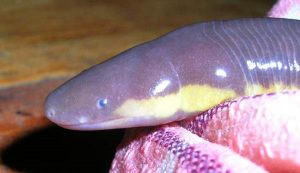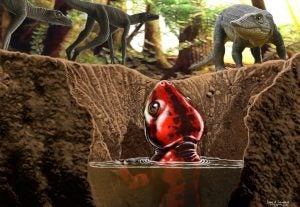Tiny fossils reveal backstory of the most mysterious amphibian alive
The two fossils from the Triassic Period are a cross between salamanders and wormlike ‘caecilians’ — their discovery fills a significant gap in the evolutionary history of frogs, toads and other amphibians
Contact: Zen Vuong, (213) 300-1381 or zvuong@usc.edu
Researchers have determined that the fossils of an extinct species from the Triassic Period are the long-missing link that connects Kermit the Frog’s amphibian brethren to wormlike creatures with a backbone and two rows of sharp teeth.
Named Chinlestegophis jenkinsi, the newfound fossil is the oldest relative of the most mysterious group of amphibians: caecilians. Today, these limbless, colorful serpentine carnivores live underground and range in size from 6 inches to 5 feet.
“Our textbook-changing discovery will require paleontologists to re-evaluate the timing of the origin of modern amphibian groups and how they evolved,” said Adam Huttenlocker, senior author of the study and an assistant professor in the Department of Integrative Anatomical Sciences at the Keck School of Medicine of USC.
The study, published in Proceedings of the National Academy of Sciences on June 19, expands the known history of frogs, toads and salamanders by at least 15 million years and closes a major gap in early caecilian evolution by connecting them to stereospondyls, animals with toilet-seat heads that were the most diverse amphibian group during the Triassic era more than 200 million years ago.
Scientists previously believed the story of the stereospondyl order was a dead-end because, although widespread during the Triassic Period, the animals were believed to be unrelated to anything alive today. The two recently discovered fossils dispel that theory and suggest that the amphibian lineage of today evolved from a common ancestor some 315 million years ago.
“Caecilians are hard to find in the fossil record because most are so small,” Huttenlocker said. “Chinlestegophis jenkinsi still preserves a lot of the primitive morphology that is shared with other Triassic amphibians, namely their four legs.”
Before C. jenkinsi, scientists had found only two other caecilian fossils from the Age of Dinosaurs and — unlike the two recently unearthed — those came later and had reduced limbs, more closely resembling their contemporary living relatives.
“It’s possible that the things that frog and salamander tissue can do when it comes to scarless healing are also present in human DNA but may be turned off,” said Jason Pardo, lead author of the study and a doctoral candidate in the Faculty of Veterinary Medicine at the University of Calgary in Alberta, Canada. “Because humans are also vertebrates, we enhance our understanding of our own evolutionary history and genetic heritage when we gain understanding of the amphibian lineage.”
Solving mysteries in vertebrate evolution

There are currently fewer than 200 species of caecilians, which live in the wet, tropical regions of South America, Africa and Southeast Asia. But the two ancient fossil amphibians found in the late 1990s by Bryan Small, study co-author and a research associate at Texas Tech University, were preserved in the fossilized burrows of Eagle County, Colo.
The paleontologists used 3-D X-rays to reassemble the fossil remains of two C. jenkinsi specimens. Parts of a skull, spinal column, ribs, shoulder and legs survived in the fossils of the first specimen. Only the skull was distinguishable in the second specimen.
“Twenty to 30 years ago, we weren’t even sure of the origins of birds,” Pardo said. “Now we are solving some of the final remaining mysteries when it comes to what sorts of animals the major vertebrate groups evolved from. Caecilians, turtles and some fish are the only major vertebrate groups that paleontologists still have questions about.”
Characteristics of the ancient caecilian
The burrows these fossils were preserved in were almost 2 inches wide, meaning they could not have been very big. Their bullet-shaped skulls were just under 1 inch long, so the ancient caecilian was probably about the size of a small salamander, Huttenlocker said.
The length of the animal is unknown because researchers do not have the full fossil remains of the animal, but Pardo estimates that the ancient caecilian was between 6 inches to a foot long. As a small carnivore, it probably ate insects.
Its eyes would have been functional but tiny. Some of today’s caecilians do not have eyes or they are hidden under moist skin.
During the summer, this central Colorado area would have been scorching, which is probably why these subterranean animals thrived. Big dinosaurs like early relatives of the Tyrannosaurus rex and Triceratops could not have existed in such conditions, Huttenlocker said.
“The ancient caecilians lived in these burrows deep in the soil down to about the level of the water table so that they could keep wet and avoid the extreme aridity from the dry season,” Huttenlocker said. “I’m going back to Colorado this summer and hope to find more animals with more complete skeletons. We’ll find one. This is just the initial report.”
Field work for the study was supported by permits from the U.S. Department of the Interior’s Bureau of Land Management (BLM-CO-49819 & CO-49819d and BLM-CO-76493 & BLM-CO-78401).
###
ABOUT THE KECK SCHOOL OF MEDICINE OF USC
Founded in 1885, the Keck School of Medicine of USC is among the nation’s leaders in innovative patient care, scientific discovery, education, and community service. It is part of Keck Medicine of USC, the University of Southern California’s medical enterprise, one of only two university-owned academic medical centers in the Los Angeles area. This includes the Keck Medical Center of USC, composed of the Keck Hospital of USC and the USC Norris Cancer Hospital. The two world-class, USC-owned hospitals are staffed by more than 500 physicians who are faculty at the Keck School. The school today has approximately 1,650 full-time faculty members and voluntary faculty of more than 2,400 physicians. These faculty direct the education of approximately 700 medical students and 1,000 students pursuing graduate and post-graduate degrees. The school trains more than 900 resident physicians in more than 50 specialty or subspecialty programs and is the largest educator of physicians practicing in Southern California. Together, the school’s faculty and residents serve more than 1.5 million patients each year at Keck Hospital of USC and USC Norris Cancer Hospital, as well as USC-affiliated hospitals Children’s Hospital Los Angeles and Los Angeles County + USC Medical Center. Keck School faculty also conduct research and teach at several research centers and institutes, including the USC Norris Comprehensive Cancer Center, the Zilkha Neurogenetic Institute, the Eli and Edythe Broad Center for Stem Cell Research and Regenerative Medicine at USC, the USC Cardiovascular Thoracic Institute, the USC Roski Eye Institute and the USC Institute of Urology.
In 2016, U.S. News & World Report ranked Keck School of Medicine among the Top 40 medical schools in the country.
For more information, go to keck.usc.edu.
Illustration: Chinlestegophis jenkinsi was a tiny subterranean carnivore and is an ancient relative of frogs and salamanders. (Illustration/ Jorge Gonzalez)
Image: Today’s caecilians are limbless, colorful serpentine carnivores that live underground and range in size from 6 inches to 5 feet. (Creative Commons/Shyamal)

